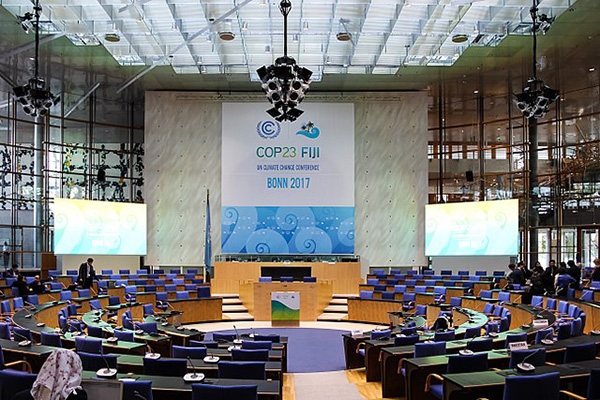Theme1
International resolve to address climate change infused COP23 with an inclusive spirit that resulted in enough progress to take us through to negotiation crunch-time at COP24. The well-below 2ºC degree guardrail, our collectively agreed temperature goal, is still however stubbornly out of reach.
Summary
Tackling climate change in earnest requires governing a ‘super wicked’ collective action problem through non-marginal actions across time horizons that expand regular market timescales. From scientists to policymakers and individuals we all need to be involved. Increasingly ambitious global action is key, as analyses by the World Meteorological Organisation (WMO) and the United Nations Environment Programme (UNEP) released prior to COP23 confirm that greenhouse gas emissions are still on the rise while efforts to reduce emissions are insufficient to hold temperature increases to a bearable level in a year in which the world has endured significant extreme weather events. Physical risks from climate change are increasingly clear.
The Paris Agreement provided the collective framework to limit temperature increases to well below 2ºC above preindustrial levels, but international rules that will govern the Paris Agreement are yet to be finalised. National climate laws and policies that are fostered, inter alia, by the Paris Agreement ensure action on the ground. Appropriation of new and existing climate policies is key to ensure their implementation. Citizen concern seems to be mounting, thus favouring increasingly ambitious climate regulation, although further action is needed. The current legal and social contexts highlight both transition risks and market opportunities for stakeholders as a function of their climate action.
Recent developments in climate science, legislation, litigation and citizen engagement provide the context in which international climate negotiations took place in Bonn this year. COP23 delivered, as expected, the necessary procedural progress to consider this COP successful. Negotiations advanced on the inclusion of Parties’ preferred options for the development of implementation guidelines (previously known as the Paris rulebook) that are to govern the Paris Agreement. Progress was also made on evaluating global progress towards our long-term temperature stabilisation target, as the design of the 2018 Facilitative Dialogue (renamed the Talanoa dialogue) was completed. Concrete outcomes were also achieved as regards the Vulnerability Agenda on gender, indigenous peoples, local communities and oceans. Intense negotiations at COP23 helped broker an agreement on agriculture after years of paralysis on this topic. At the request of developing countries, the pre-2020 ambition, an unexpected negotiating issue, was raised to the fore. Developed countries will be subject to evaluation as regards ambition and finance in 2018 and 2019. The Adaptation Fund, which was to expire with the second phase of the Kyoto Protocol, will continue serving under the Paris Agreement, an additional win for developing countries.
On Fiji’s expected grand coalition of actors, and building on the work undertaken at Lima (COP20), Paris (COP21) and Marrakech (COP22), the first formal dialogue between non-state actors (sub-national governments, the business sector and civil society) and Parties (national governments) was held in Bonn. Additionally, the Marrakech Partnership for Global Climate Action, that seeks to promote pre-2020 ambition, presented its first Yearbook on Global Climate Action. Given the realisation that non-state actors are crucial in the push towards a lower carbon development model, and building too on the increased interest by non-state actors to contribute to the low carbon transition, it is expected that future international climate meetings advance this dialogue. The meeting of the 2050 Pathways Platform to foster the development of long-term decarbonisation pathways also took place in Bonn.
Analysis
Science: urgent climate action required
As COP23 opened in Bonn, the World Meteorological Organisation (WMO) informed that 2017 was set to be the warmest year ever recorded without an El Niño2 event, and one of the three hottest years on record overall. This year the world has experienced record Extreme Weather Events (EWE), including hurricanes in the Caribbean and the southern parts of the US, the highest cyclonic September on record, global ocean heat content also reaching record levels, continued droughts in Somalia and above-average rainfall in some parts of India leading to significant floods.3 Although single events are difficult to attribute to climate change, as changes in climate patterns are studied over several decades (or longer), scientists agree that climate change is expected to bring increased frequency and severity of EWE such as those we have endured in 2017.
The eighth edition of the UNEP Emissions Gap Report,4 which analyses the information included in the IPCC’s Fifth Assessment Report, as well as more updated studies, provides a further warning signal. Full implementation of countries’ Nationally Developed Contributions (NDCs) will only provide one third of the emission reductions needed to meet our 2ºC goal in the most cost-effective manner. In terms of emissions, this implies having a gap (distance to the well-below 2ºC target) of 11 gigatonnes of carbon dioxide equivalent (GtCO2e) if conditional pledges are implemented and a 13.5GtCO2e gap if unconditional pledges are implemented. For the 1.5ºC target, the gap would increase to 16GtCO2e and 19GtCO2e respectively. The gap between our intentions (NDCs) and the 2ºC target is, according to UNEP ‘alarmingly high’.5
By 2030 the implementation of current commitments will use up 80% of the carbon budget6 to stay within the 2ºC temperature limit. Furthermore, the carbon budget for limiting temperature increases to 1.5ºC will be completely exhausted by 2030 if ambition is not ramped up. Therefore, the deadline to close the gap is 2030 if the world is to transition to a low-carbon model in a cost-effective manner. Hence, the 2018 Talanoa dialogue, the first global exam of our collective progress towards the long-term temperature stabilisation target, that will inform the 2020 revision of countries commitments (with a 2030 timeframe for NDCs), is critical in ensuring the world is ratcheting-up climate action.
The UNEP report does, however, provide some guidance as regards the sectors that have significant greenhouse gas (GHG) reduction potential. Over two-thirds of the potential comes from the energy, industrial and transport sectors. The uptake of low carbon energies including renewable energies, the use of carbon capture and storage,7 the recovery and re-use of methane in gas production or the pre-mining degasification in coal mining are some of the key actions that can be taken by the energy sector. Increasing energy efficiency, increasing the use of renewable energy to produce heat, using carbon capture and storage and reducing hydroflourocarbons are actions the industrial sector can take to reduce its GHG emissions according to UNEP. Fuel efficiency measures, transport modal shifts and increasing the use of electric vehicles are the key GHG reduction initiatives suggested for the transport sector.
Climate governance and legislation: the push from above
Since the Kyoto Protocol was adopted in 1997 climate laws and policies have increased twentyfold. This surge in climate legislation indicates greater concern and action to provide a stable climate as a global public good. Interestingly, and perhaps expectedly, it is developing countries that have put in place greater number of climate laws since 19948 although full integration of climate policy in development policy is yet to occur in developed and developing countries alike. Figure 1 below portrays climate-related laws and policies passed or enacted yearly from pre-1994 to 2016.
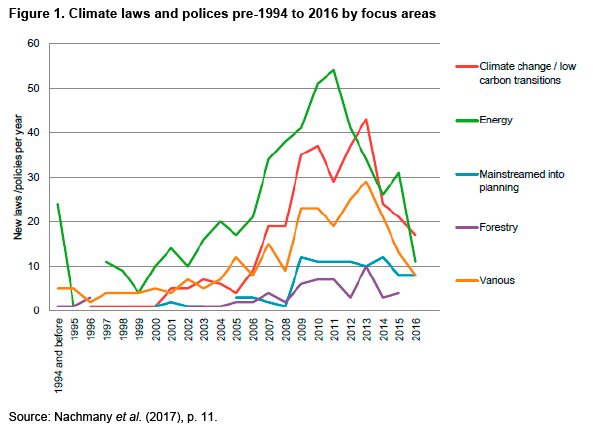
The key areas in which global climate laws and policies focus include: the energy sector, accounting for 41% of total climate legislation; low carbon transitions accounting for just under 26% of climate laws; general environmental laws (under 12% of the laws); mainstreaming climate change into planning processes (7.7% of the laws) and the forestry sector (under 5% of the laws analysed).
The reduction in the amount of laws nearing 2016 that can be seen in Figure 1 above might soon be reversed. This is so as the entry into force of the Paris Agreement legally binds countries to present their Nationally Determined Contributions (NDCs) every five years, which could mean an increase in the number of climate-related laws and policies in the coming years. For instance, given that 90% of NDCs9 include the agricultural sector, that it is an under-legislated area and that there has been a decision at COP23, more national regulation in the agricultural sector could be seen in the future.10
Similarly, litigation has also increased throughout the 1994-2016 period analysed. At least 825 court cases related to climate change have been recorded, 600 of which are US-based. Although in most of the court cases to date climate change is not the main concern, this may well change in the future. One possible explanation for this increase in future climate litigation is that it is increasingly perceived as a valid strategy to drive climate action.
Three recent cases illustrate this increased demand for action. First, in October 2016 a group of young plaintiffs and the climate scientist Dr James Hansen won the right to trial according to US District Court Judge Anne Aiken. The plaintiffs argued that the US government had not upheld its obligation to ensure a stable climate, in line with the public trust doctrine, endangering plaintiffs’ fundamental rights to life and liberty. As judge Aiken stated: ‘the right to a climate system capable of sustaining human life is fundamental to a free and ordered society’.11 Secondly, during COP23, in November 2017 a German regional court deemed a Peruvian farmer’s demand for damages admissible. The farmer was demanding Germany’s RWE (one of the largest greenhouse-gas emitters) to contribute to the protection of his town in Peru that is at risk of overflows from a melting glacier. Lastly, in the Netherlands a Dutch court determined that, based on established climate science, the government had to increase its climate ambition by reducing greenhouse gas emissions by 25% by 2020 compared to 1990.12 Although in countries such as Spain a significant number of climate litigation cases in the past have been motivated by disputes between companies that operate under the European Emission Trading System (EU ETS) and the national government regarding allocated emission allowances,13 this need not be the case in the future.
The sharp increase in climate legislation and litigation since the 90s, coupled with the expectation that the Paris Agreement will inject climate laws with renewed impetus, will no doubt be understood by stakeholders as what the future holds. The development of increasingly ambitious climate laws exemplifies one of the transition risks laggards will face.
Society: increasingly concerned worldwide but actions lagging behind
Concern for climate change has waxed and waned for over three decades14 subject to economic development, political support for climate action, increased experience with climate-change related impacts materialising15 and heightened media coverage of climate change, among others (see Figure 2 below).
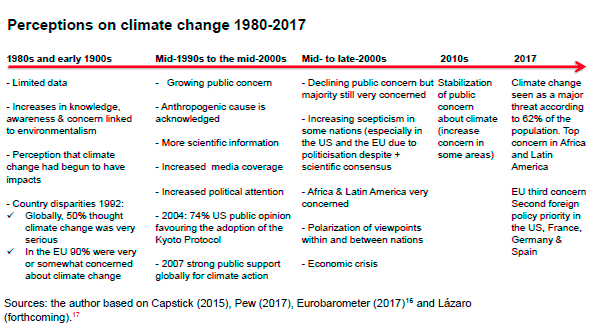
Sources: the author based on Capstick (2015), Pew (2017), Eurobarometer (2017)16 and Lázaro (forthcoming).17
The underlying trend, however, seems to point towards an increase in citizen concern about climate change. This can turn into demand for action from policymakers and businesses as part of a new social contract.18 For instance, in May 2017 a majority of Exxon Mobil shareholders voted19 for greater disclosure from the company as regards the company’s exposure to climate risks, a first in the firm’s history, with institutional investors strongly pushing for this move.20
As reported in the latest surveys, climate change is Africa’s and Latin America’s primary concern as a threat to their countries while in Europe and the US climate change is the second concern for citizens after international terrorism, according to the latest research published by Pew (2017).21 According to the 2017 Eurobarometer climate change is the third most serious problem facing the world for Europeans, preceded by poverty, hunger plus lack of drinking water, and international terrorism. For two EU countries, however, Sweden and Denmark, climate change is the most serious problem facing the world. As regards foreign policy priorities, citizens in the US, Germany and France rank fighting climate change as their second priority after fighting international terrorism.22 In Spain climate change has consistently been ranked as a second foreign policy priority from 2011 to 2016.23
So citizen concern about climate change is significant and indicates that, at least in some jurisdictions, foreign policy is expected to engage in earnest with climate action. As regards the willingness to pay for climate policies, analyses show it is, overall, significantly different from zero,24 albeit with stark geographical differences.25 As for individual’s self-reported behaviour regarding climate change, the latest Eurobarometer states that 49% of Europeans spontaneously report climate-conscious behaviour such as separating waste and reducing waste, but when prompted with specific examples of these types of behaviour the percentages reaches 90% of Eropeans.
Actions to curb GHG emissions at an individual level are, however, yet to follow in earnest according to per capita GHG emission accounts (see Figure 3 below), despite energy-related CO2 emissions having stalled in the past three years (IEA, 2017)26 (see Figure 4 below).
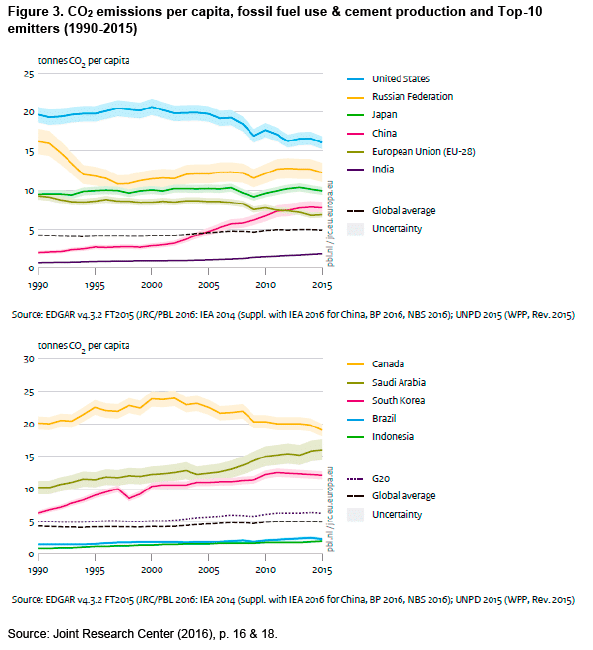
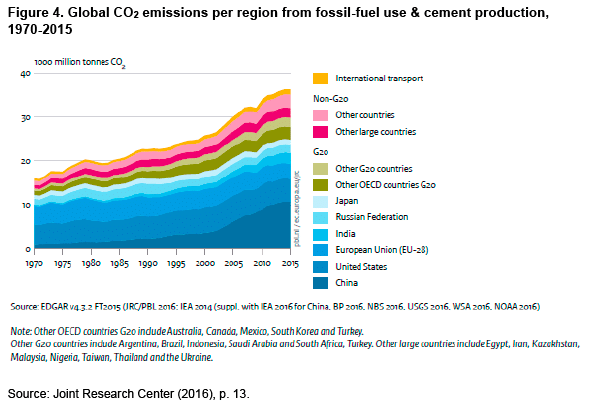
Furthermore, citizens cite national governments, the EU and business and industry as the key institutions that should engage in climate action, which highlights the market and reputational transition risks different stakeholders can expect.
COP23 in context: enough to keep going but immense work ahead
In the aftermath of the adoption of the Paris Agreement at COP21, seasoned negotiators, observers and researcher alike started warning the international community that implementation and increased ambition, subject to adequate means,27 were paramount to take Paris beyond a diplomatic success.
COP22 provided the timeframe for finalising the implementation guidelines for the Paris Agreement, ie, the set of rules, modalities and procedures that will make the Paris Agreement operational. The rulebook deadline, which coincides with the Facilitative Dialogue enshrined in the Paris Agreement (now known as the Talanoa dialogue),28 was set in 2018. COP24 is therefore set to be a decisive milestone in the fight against climate change. Hence, the expectations for COP23 were those corresponding to a technical international climate meeting. And yet, the work during 2017 and 2018, prior to COP24, is of utmost importance in determining the resilience, effectiveness and buy-in of the Paris Agreement.
As regards the resilience of the Paris Agreement, 2017 was a premature test for global climate action. Prior to this year’s COP, on 1 June 2017, the 45th president of the US announced his intention to withdraw from the Paris Agreement. The arguments for withdrawing from the agreement were based on the misunderstanding or misrepresenting of three key issues:29
- The nature of the Paris Agreement. This is an agreement in part crafted to suit US political circumstances (ie, circumvent America’s political gridlock on climate change). It is only binding on procedural issues and explicitly excludes the possibility of being exposed to liability claims for losses and damages. The Paris Agreement, like any other international environmental agreement, has not been imposed on any country by any other country as Donald Trump claimed. The Paris Agreement is a voluntary undertaking. Additionally, all Parties to the Agreement have expressed their voluntary commitments through Nationally Determined Contributions (NDCs) according to their national circumstances, ie, they are asymmetric in nature to allow for differentiation in terms of will and xapacity to act.
- The economics of climate action. Trump misleadingly cited a partial study30 to provide only cost estimates of climate action, forgetting his own Environmental Protection Agency (EPA) estimates of the benefits of globally-concerted climate action.31
- The scientific consensus on the impacts of climate action. The insufficiency of current NDCs notwithstanding, Trump underestimated the impacts of current mitigation commitment by a large quantity.32
Although every diplomatic effort, both within and outside the White House, was made during 2016 and 2017 to prevent the withdrawal announcement, on 4 August 2017 the Department of State announced the US had submitted a letter to the UN expressing America’s intent to withdraw from the Paris Agreement as soon as possible.33 A withdrawal that, according to article 28 of the Paris Agreement, would not occur before Trumps’ term in office ends. In the meantime, the US has sent a technical-profile group of seasoned negotiators to COP23, and will continue sending an official delegation to the negotiation in order to ‘to protect US interests and ensure all future policy options remain open to the administration’.34 Even though the official US delegation at COP23 has not had a leading role in the negotiations, it has been argued that it has not disrupted the negotiations either.
The political declarations during COP22 regarding the resolve to push ahead with the climate action agenda have fortunately proceeded apace throughout 2017. This should not be mistaken, however, with an innocuous US climate default. America’s first climate default (when it failed to ratify the Kyoto Protocol) arguably resulted in lowering ambition and expectations as regards climate action, something we cannot afford at present according to climate science. Trump’s decisions on cutting international climate finance can hinder cooperation between developed and developing countries, slowing down, to some extent, the low-carbon transition and leapfrogging processes in the latter. Trump’s disregard for established climate science, with currents reports of lawyers in the Justice Department questioning climate scientists regarding uncertainties in the science,35 his announced budget cuts to the EPA as well as to international institutions such as the IPCC, and the limitation imposed on EPA’s scientists to disclose their findings, can endanger the traditionally world-class climate science that, along with many other institutions worldwide, inform international climate negotiations and actions.
Europe’s resolve to fill the finance gap, as exemplified by declarations such as those of President Macron during COP23 and the UK Department for Business, Energy and Industrial Strategy (BEIS),36 the significant contribution by the EU to international climate finance, €20.2 billion in 2016 according to the Council of the EU,37 and the decisive support of climate scientists working, among others, at the Joint Research Center, the Copernicus Programme, Barcelona’s Supercomputing Center and H2020 programmes, will in all likelihood become increasingly important to fill the science-finance void left by the US.
As regards China, its New Normal economic38 development and its overwhelming investment in renewables39 provide reasons for optimism. However, China’s expected leadership role that was envisaged after Xi Jinping’s speech at the World Economic Forum in 201740 has arguably not yet materialised in international climate negotiations. China’s historical principled resistance to external oversight of emissions has been a stumbling block during COP23. This is so despite its technical capabilities41 as regards satellite monitoring of greenhouse gas emissions. The leadership role in international climate negotiations seems to be (at least partially) vacant for the time being.
COP23 priorities and key results
Prior to the celebration of COP23 in Bonn, under the Fiji Presidency, the key priorities were to advance on the rules that will govern the Paris Agreement, to design the first exam of the advances made towards meeting our long-term temperature goal, to advance on the vulnerability agenda and to foster climate finance. All these while avoiding re-opening issues that had been agreed in Paris and in Marrakech such as that on differentiation between developed and developing countries (see Box 1 below).
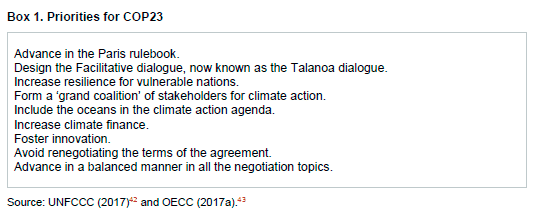
Source: UNFCCC (2017)42 and OECC (2017a).43
Some of the key outcomes of COP23 include: (1) the Paris work programme; (2) finalising the design of the Talanoa dialogue; (3) reaching an agreement on evaluating pre-2020 ambitions and requesting ratification of the Doha Amendment; (4) progress on the Vulnerability Agenda; and (5) the grand coalition, or the increasing (yet still fuzzy) role of non-state actors.
(1) The Paris work programme44
The implementation guidelines have made progress. The negotiating texts being developed for the implementation of the Paris Agreement managed to include the preferred options from all Parties. This was essential in ensuring the appropriation by all countries of the rulebook that will govern the implementation of the Paris Agreement. The work ahead will entail treamlining the negotiating texts that it is to be hoped will be adopted in COP24. As the amount of work ahead is immense, the topic complex and the issues of mitigation, adaptation, finance, technology and capacity building are highly interlinked, there will be an additional negotiating session in the period between May 2018 and COP24. Additionally, there was a request to the UNFCCC secretariat to develop an online platform to track the progress made in the Paris work programme. The goal is to avoid having lengthy negotiations such as those prior to the entry into force of the Kyoto Protocol. The key outcomes are presented in Table 1 below.
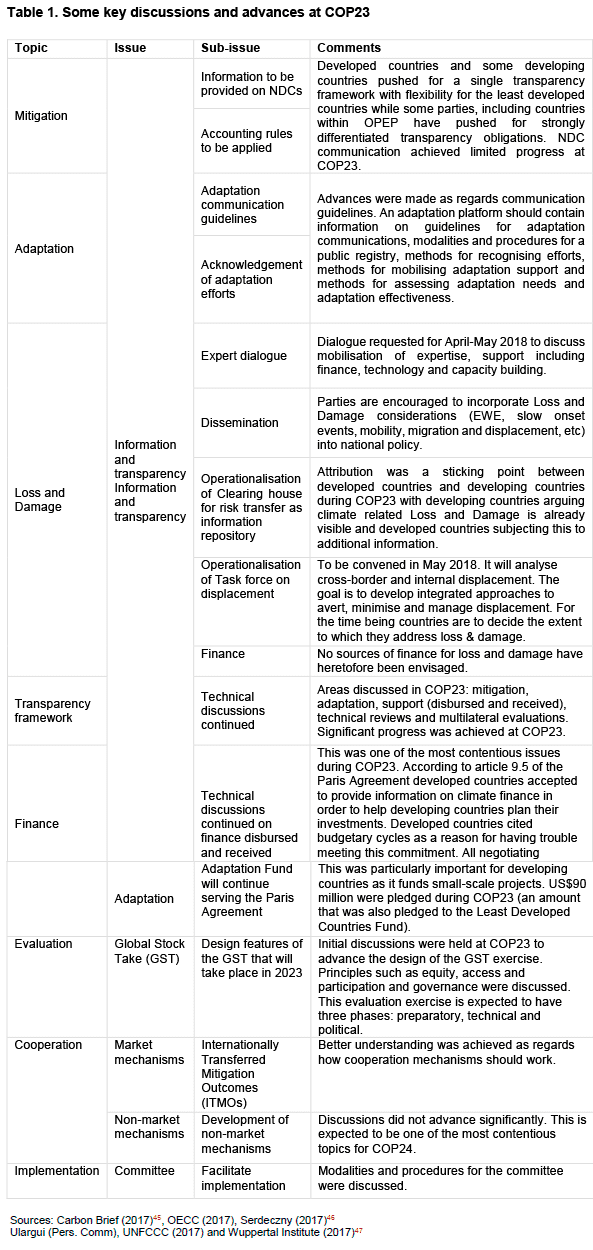
Sources: Carbon Brief (2017)45, OECC (2017), Serdeczny (2017)46
Ulargui(Pers. Comm), UNFCCC (2017) and Wuppertal Institute (2017)47
(2) Finalising the design of the Talanoa dialogue
Previously known as the Facilitative dialogue the Talanoa dialogue will take place throughout 2018 and will conclude in COP24. The goals of this first evaluation are to analyse the progress towards our long-term temperature stabilisation goal and to inform the upcoming review of national commitments (NDCs) in 2020 in which ambition has to be increased. The key features of this dialogue will be the inclusive, participatory and non-confrontational nature of the analysis, in line with the Talanoa spirit.
The Talanoa dialogue is structured in two phases. The first phase is a technical one that will gather evidence from scientific institutions (eg, the IPCC’s special report on climate change scenarios in a 1.5ºC warmer world), stakeholders and Technical Expert Meetings (TEMs) and will summarise the information for the second phase (the political phase) that will report on the findings of the dialogue and will help in the development of the next generation Nationally Determined Contributions (NDCs).
Parties are expected to bring to the Talanoa dialogue their national or regional progress and initiatives to achieve the long-term temperature goal. In this respect, the EU has communicated during COP23 that it will strive to bring to the table the most advanced legislative package possible, which includes the recently reformed EU ETS,48 the Effort Sharing Regulation proposal for 2021-30,49 the land use and forestry proposal for 2021-3050 and the energy Package.51 This, it is hoped, will demonstrate that the EU is a credible and ambitious partner. The EU claims that not only does it have a strong track record in climate action, having disbursed €20.2 billion in climate finance last year and decoupling economic growth from greenhouse gas emissions, as GDP has grown over 50% since 1990 while emissions have fallen over 20%, it also has a clear vision of how to decarbonise its economy and it has in place (or it is developing) the policies to support the low carbon transition.
(3) Reaching an agreement on evaluating pre-2020 ambitions and requesting ratification of the Doha Amendment
Pre-2020 ambition was, arguably, an unexpected negotiating topic at COP23. The African Group wanted to ensure climate actions and finance were disclosed prior to the implementation of the first set of NDCs, to ensure continued post-2020 ambition. The EU’s expected overachievement of 2020 goals plus its significant contribution to international climate finance, and its recurrent narrative of Europe’s will to keep leading by example voiced by Commissioner Arias Cañete, were some of the drivers for the EU agreeing to the decisions taken on pre-2020 ambition.
The pre-2020 decisions include, first, sending letters to Parties to the Kyoto Protocol to ratify the Doha Amendment so that the second period of the Kyoto Protocol (2013-20) would enter into force. The EU stated it would strive to send its ratification before the end of 2018 and Spain deposited its instrument of ratification on 14 November 2017, joining 15 other EU countries that have also ratified the Doha Amendment.52 The EU ratification has not materialised yet due to the Polish veto to ratify, but Poland has announced it will do so ahead of COP24,53 which will be hosted in Katowice under its Presidency.54 The EU’s ratification will not, however, imply crossing the threshold for the Doha Amendment to enter into force. Secondly, the decision was taken to hold a stock-taking meeting in 2018 and 2019 in which mitigation efforts, support and information regarding the actions under the Marrakech Partnership for Global Climate Action by non-Party stakeholders will be analysed.
(4) Progress on the Vulnerability Agenda
The first COP presided by a Small Island Developing State (SIDS), plus a year of extreme weather events, fostered the vulnerability agenda at COP23. The outcomes within this agenda included:
(a) The establishment of a Gender Action Plan55 in order to mainstream gender-responsive climate action. Mainstreaming would in turn result in increasing capacity building through, inter alia, specific training programmes, increasing access of women to the international climate negotiating process and fostering gender-related approaches in national climate action plans.
(b) The development of the local communities and indigenous peoples platform56 whose goal is to preserve local and indigenous knowledge through the exchange of information and best practices. It also aims to improve local communities and indigenous peoples’ access to the international climate negotiation process and to improve the communication between the platform and other stakeholders.
(5) The grand coalition, or the increasing (yet still fuzzy) role of non-state actors
The first formal open dialogue between Party (national governments) and non-Party stakeholders (subnational governments, cities, firms and civil society) took place at COP23.57 A dialogue that is expected to continue in future COPs.
A permanent dialogue mechanism between Parties and non-Party stakeholders has been recognised as key to deliver effective climate action. Bottom-up actions by non-state actors have surged since Copenhagen (COP15), with cities for example demanding greater involvement in the UNFCCC process.58 Key initiatives in the post Copenhagen era include:
(a) The Lima-Paris Action Agenda and the establishment of the Non-state actor Zone for Climate Action (NAZCA) platform at COP20 in Lima that records commitments by non-Party stakeholders.
(b) The development of the roadmap for Global Climate Action59 at COP21 in Paris to enable the formal liaison between Party and on-Party stakeholders, with Laurence Tubiana and Hakima el Haite as High-Level Climate Champions.
(c) Also at the behest of the first climate champions, the 2050 Pathways Platform60 was launched at COP22. The key goal of this initiative is to support governments at all levels as well as companies61 to develop long-term decarbonisation strategies to achieve the long-term net-zero GHG goal. During COP23 Spain announced it had joined the 2050 Pathways Platform.
(d) The Marrakech Partnership for Global Climate Action62 that seeks to enhance pre-2020 actions and engagement by Party and non-Party stakeholders, which is complementary to Party negotiations. The Marrakech Partnership also tracks progress by non-party stakeholders using the NAZCA platform and reports actions annually in the Yearbook of Global Climate Action.
The first Yearbook on Global Climate Action was published in 2017. Although the yearbook has, understandably, not recorded all on-going initiatives, the following show the widespread engagement by non-Party stakeholders. First, over one billion (109) people have committed to reduce their GHG emissions by 80% by mid-century. Secondly, water adaptation capacity is to be scaled up by megacities with over 300 million inhabitants, with a significant number of initiatives being announced in developing countries. Third, a significant number of companies are committing to using 100% renewable energy. Companies are also increasingly willing to be subject to science-based targets in line with a 2ºC temperature target in their GHG reduction commitments. This alignment with science-based targets can furthermore help future capital allocation decisions by institutional investors that are increasingly mindful of companies’ exposure to climate risks. Science-led climate action and disclosure is potentially a means for attracting investment.
One of the most notable initiatives as regards non-Party stakeholders at COP23 was arguably the presentation of America’s Pledge, an initiative developed by cities, businesses and civil society in the US that was presented by Michael Bloomberg and Jerry Brown. In contrast with Donald Trump’s announcement to withdraw from the Paris Agreement, over half of America’s population (amounting to over half of the US GDP, equivalent to the third-largest GHG emitter globally) committed to uphold the goals of the Paris Agreement. This contrasted to the relatively low profile of the US delegation at COP23 that focused its work on, inter alia, a working group on NDC implementation, loss and damage, climate finance and avoiding reopening the issue of country differentiation. The only official American side event at COP23, titled ‘Cleaner and More Efficient Fossil Fuels and Nuclear Power in Climate Mitigation’, was disrupted by protesters, a clear sign of the deep divide in the US between the federal government and non-Party stakeholders.
The key gaps identified to implement and scale-up climate action in the 2017 Yearbook on Global Climate Action are: integrating approaches, closing the financial gaps, enhancing capacity and addressing technology and information gaps. Moving forward, however, the challenges include: institutionalising the Marrakech Partnership for Global Climate Action and ensuring it has the appropriate means to develop its work; and setting up a system to account rigorously for all non-state actor climate actions in a transparent way that can be verified and compared and that ensures non-Party commitments are additional to Party commitments. The design of this accounting mechanism is expected to occur after the implementation guidelines for the Paris Agreement are finalised.
An additional high-profile initiative presented at COP23 was the Powering Past Coal Alliance,63 fostered by the governments of the UK and Canada. Initially signed by 25 governments (national and subnational) the alliance seeks to accelerate traditional coal phase-out (ie, coal-fired power plants without Carbon Capture and Storage, CCS).64 At the One Planet Summit that marked the 2nd anniversary of the Paris Agreement,65 24 businesses and other organisations joined the initial list of national and sub-national signatories of the Powering Past Coal Alliance.66
Based on the work by Climate Analytics,67 the alliance declaration states that given that 40% of current electricity worldwide is supplied by coal and that there are significant health impacts from the use of coal for electricity production, amounting to 800,000 deaths a year, traditional coal should be phased out. This phase-out, it is argued, should occur by 2030 in the OECD and the EU and by 2050 in the rest of the world. As regards Spain, the question was asked during COP23 regarding the potential adherence to the Powering Past Coal Alliance. At present, the reasons given for not doing so include the potential increase in the price of electricity,68 the job losses this would entail and the need to ensure security of supply. There is, however, an on-going dialogue with the energy sector regarding the coal phase-out.69
Other achievements
Other achievements include: (1) breaking the gridlock on agriculture; (2) launching the Ocean Pathway at COP23; and (3) involving institutional investors in climate change.
Breaking the gridlock on agriculture70
After years of unfruitful negotiations, COP23 brought greater understanding and trust among Parties as regards agriculture. In moving forward, the Subsidiary Body for Implementation (SBI) and the Subsidiary Body for Scientific and Technological Advice (SBSTA) will jointly address the topic of agriculture and climate change through workshops and expert meetings. The topics to be addressed are yet to be finalised but they are expected to include the enhancement of soil carbon, increasing adaptation and resilience, improving livestock and food security. The issue of how to account for emissions by the agricultural sector was a contentious one once again during COP23, with methane at the centre of the disputes. Latin American countries including Brazil, Argentina and Uruguay71 (with a large cattle industry) raised, once again, the issue of the disadvantages they faced due to the current Global Warming Potential72 used to calculate the warming impact of methane.73
Launching the Ocean Pathway74 at COP23
This initiative seeks to include the issue of oceans and climate change within the UNFCCC negotiations given the importance of oceans for SIDS and coastal states and the role that oceans play in (and impacts they endure from) climate change.75 It also seeks to include ocean-related climate mitigation and adaptation actions in NDCs. The IPCC is additionally preparing a Special Report on the Ocean and Cryosphere in a Changing Climate (SROCC)76 that will be published in 2019 and that will inform the debate moving forward.
Involving institutional investors in climate change
Some of the key messages coming from investors both prior77 to and during COP23 as regards climate change include the reiteration that climate change is increasingly being considered a systemic risk. Climate change may reduce the value of assets under management due to both physical and transition risks. Climate action is in turn seen as a potential value-creating-strategy. More is being done, though, on the side of mitigation than on the side of adaptation for the time being. Some of the requests from investors to ramp-up climate finance include:
- Embedding climate finance considerations both in future rounds of NDCs (starting in 2020) and in the development of national climate policies.78
- Fostering blended finance so that investment risks be minimised.
- Ensuring predictable climate (and related) policies to attract climate finance.
- Providing ex ante public climate finance information to enable low carbon investment in developing countries, a demand by institutional investors that is aligned with that of developing countries, and which is enshrined in article 9.5 of the Paris Agreement.
- Project aggregation to ensure institutional investors can finance the low carbon transition.
- Ensuring independent science-based targets guide national climate policies.
- The most progressive climate laws and policies have introduced institutions and mechanisms that respond to institutional investors’ demands, among other, to help secure future capital for the low carbon transition.
Conclusions
Reflecting on the results of COP23
On evaluating the results of a largely technical COP it is important to reflect on the goals set for such a meeting, the broader temperature stabilisation goal and contextual factors.
As regards the goals set and the expectations on achieving these goals prior to the meeting in Bonn, the outcome could be judged as positive. Despite the temptations to reopen historical discussions on differentiation, and the expected wrangling on ex ante information relative to international climate finance, COP23 managed to advance on the Paris work programme by producing a set of pre-negotiation texts that are acceptable to all Parties. Inclusiveness and trust are known to be key drivers of climate negotiations and thus having all options in the texts that contain the rules (implementation guidelines) that will govern the Paris Agreement was crucial in moving forward. Such all-encompassing negotiating texts have to be narrowed down prior to the celebration of COP24 in December 2018. The workload is such that at COP23 an additional negotiating session prior to COP24 was planned. Some negotiators are somewhat sceptical of the possibility of closing every negotiating item on time, despite this additional session.
The second key goal of COP23 was the design of the Talanoa dialogue, which was achieved. It is unclear at this stage whether the inputs from the IPCC and other stakeholders, which will be reviewed prior to the political phase of the dialogue, will be enough to spur the increase in ambition that is needed to ensure we do not overshoot our long-term temperature goal. The first key test of the Talanoa dialogue will come in 2020 when Parties have to submit their updated NDCs, with commitments to be met in 2030. The third key goal of COP23 was the advancement of the vulnerability agenda. Both the Gender Action Plan and the platform for local communities and indigenous peoples have been long-awaited and positive outcomes. Advances on agriculture materialise at COP23, after years of entrenchment.
Finally, the advancement of the Global Climate Action Agenda was arguably the space where the greatest climate action and engagement were seen during COP23. This multi-stakeholder engagement is a key element of the social appropriation of the new low carbon development model countries have signed up to.
Though the negotiation process might be progressing according to COP negotiation timescales, the progress as regards limiting temperature goals is still disappointing. GHG emissions are on the rise and 2017 has brought record extreme weather events. Speeding up the pace of negotiations and actions through the development of national climate laws with the 2050 horizon in mind is expected to be an increasingly pressing topic.
As for contextual factors, the US announcement of its intention to withdraw from the Paris Agreement could have taken a bigger short-term toll on international climate negotiations, especially if the Trump Administration had sent a high political profile negotiating team to undermine the work at COP23. No backsliding or domino effect has occurred so far, but both the international climate finance gap left by the US as well as Trump’s disregard for climate science can imperil years of hard-won trust in the international climate negotiations as well as in established climate science, two key issues to watch moving forward.
Lara Lázaro
Senior Analyst, Elcano Royal Institute | @lazarotouza
1 The author would like to thank Gonzalo Escribano Francés and Miguel Muñoz Rodríguez for their comments and suggestions on an earlier version of the article. The usual disclaimer applies.
2 According to the National Oceanographic and Atmospheric Administration (NOAA), El Niño is a ‘warming of the ocean surface, or above-average sea surface temperatures (SST), in the central and eastern tropical Pacific Ocean. Over Indonesia, rainfall tends to become reduced while rainfall increases over the tropical Pacific Ocean’ (see What is the El Niño–Southern Oscillation (ENSO) in a nutshell?, last accessed 26/XI/2017).
3 Although rainfall in India was 5% less than average, some parts in the north-east and neighbouring countries have had more severe flooding than usual.
4UNEP (2017), ‘The Emissions Gap Report 2017’, United Nations Environment Programme (UNEP), Nairobi, last accessed 26/XI/2017.
5 The emissions gap is the difference between emissions consistent with achieving a given temperature goal, say limiting temperature increases to well below 2ºC compared to pre-industrial levels, and expected emissions according to a given set of climate commitments, for instance those of current Nationally Determined Contributions, NDCs.
6 The carbon budget is the amount of carbon that can be emitted if the goal is to stay within a certain temperature rise limit. In order to limit global mean temperature increases to 2ºC compared to pre-industrial levels, the IPCC’s Fifth Assessment Report (5AR) stated that the carbon budget amounts to 2,900GtCO2, of which 65% (1,900 GtCO2) had been used up by 2011. More updated figures by Carbon Budget estimate significantly lower remaining carbon budget, reducing the amount of years we have left to exceed the 2ºC and 1.5ºC temperature targets in the next years or decades (see Analysis: Only five years left before 1.5C carbon budget is blown, last accessed 26/XI/2017). Glen Peters at CICERO reminds that at 40 GtCO2 there are only have 20 years left until the carbon budget is exhausted at current emission levels under the assumption that meeting the IPCC’s overall carbon budget will give a 66% chance of limiting temperature increases to 2ºC. It has to be noted, however, that uncertainties and model assumptions provide a range of carbon budget estimates. For further information see How much carbon dioxide can we emit? (last accessed 26/XI/2017).
7 Note that the International Energy Agency considers CCS as key to meet out climate change commitments. However, at present issues such as safety, costs and acceptance have limited the deployment of CCS. See IEA (2016), ‘20 years of carbon capture and storage. Accelerating future deployment’, last accessed 19/XII/2017; J. Fogarty & M. McCally (2010), ‘Health and safety risks of carbon capture and storage’, Journal of the American Medical Association, vol. 303, nr 1, p. 67-68, last accessed 19/XII/2017; and T. Napp (2014), ‘Attitudes and barriers to deployment of CCS from industrial sources in the UK’, Imperial College London, last accessed 19/XII/2017.
8 M. Nachmany et al. (2017), ‘Climate change laws of the world database’, Grantham Research Institute on Climate Change and the Environment and Sabin Centre for Climate Change Law, last accessed 27/XI/2017.
9 FAO (2017), ‘UN climate change conference acknowledges agriculture sectors’ critical role’, last accessed 9/XII/2017.
10 Nachmany (2017), personal comment at COP23.
11 A. Aiken (2016), ‘Kelsey Cascada Rose Juliana et al. vs. United States of America et al. Case No. 6:15-cv-01517-TC. Opinion and Order’, last accessed 2/XII/2017.
12 Q. Schiermeier (2015), ‘Landmark court ruling tells Dutch government to do more on climate change’, Nature, doi:10.1038/nature.2015.17841, last accessed 2/XII/2017.
13 Sabine Center for Climate Change Law (2017), ‘Spain archives-climate change litigation’, last accessed 2/XII/2017.
14 S. Capstick et al. (2015), ‘International trends in public perceptions of climate change over the past quarter century’, WIREs Clim Change, nr 6, p. 35-61, doi 10.1002/wcc.321.
15 Attribution studies are needed to establish the causal link between a given event and climate change. However, climate science warns that extreme weather events such as severe storms, droughts and cyclones will become more frequent and severe due to climate change.
16 European Commission (2017), ‘Special Eurobarometer 459’, last accessed 30/XI/2017.
17 L. Lázaro (forthcoming), ‘Citizens and climate change. From Homo Economicus to Homo Climaticus?’, ARI, Real Instituto Elcano.
18 N.W. Adger (2013), ‘Changing social contracts in climate change adaptation’, Nature Climate Change, doi 10.1038/NCLIMATE1751, last accessed 3/XII/2017); and R.T. Byerly (2013), ‘Business IN society: the social contract revisited’, Journal of Organisational Transformation & Social Change, vol. 10, nr 1, p. 4-20, doi 10.1179/1477963312Z.0000000002, last accessed 3/XII/2017.
19 D. Cardwell (2017), ‘Exxon Mobil shareholders demand accounting of climate change policy risks’, New York Times, 31/V/2017, last accessed 1/XII/2017.
20 Institutional Investors Group on Climate Change (2017), ‘Investors update guidance to strengthen engagement on climate risk with oil and gas companies’, last accessed 1/XII/2017.
21 Pew Research Center (2017), ‘Globally, people point to ISIS and climate change as leading security threats’, last accessed 30/XI/2017.
22 Real Instituto Elcano (2017), ‘Barómetro de la Imagen de España. 7ª oleada’, last accessed 2/XII/2017.
23 Real Instituto Elcano (2016), ‘Barómetro del Real Instituto Elcano. 38ª oleada’, last accessed 6/XII/2017.
24 M. Hanemann, X. Labandeira & M.L. Loureiro (2011), ‘Public preferences for climate change policies: evidence from Spain’, Documento de Trabajo nr 2011-06, Federación de Estudios de Economía Aplicadajo, http://documentos.fedea.net/pubs/dt/2011/dt-2011-06.pdf, last accessed 2/XII/2017.
25 E. Johnson & G. Nemet (2010), ‘Willingness to pay for climate policy: a review of estimates’, Working Paper Series, La Follette School Working Paper nr 2010-011, last accessed 30/XI/2017.
26 IEA (2017), ‘IEA finds CO2 emissions flat for third straight year even as global economy grew in 2016’, last accessed 30/XI/2017. Key contributors to current GHG emissions in percentages in 2014 include: China (30%), US (15%), EU-28 (9%), India (7%), Russia (5%), Japan (4%) and others (30%), according to T.A. Boden, G. Marland & R.J. Andres (2017), ‘National CO2 emissions from fossil-fuel burning, cement manufacture, and gas flaring: 1751-2014’, Carbon Dioxide Information Analysis Center, Oak Ridge National Laboratory, US Department of Energy, doi 10.3334/CDIAC/00001_V2017. See also WRI (2015), ‘Infographic: what do your country’s emissions look like?’, last accessed 22/XI/2017.
27 A. Averchenkova & S. Bassi (2016), ‘Beyond the targets: assessing the political credibility of pledges for the Paris Agreement. Policy brief’, Grantham Research Institute, last accessed 2/XII/2017.
28>/ UNFCCC (2017), ‘2018 Talanoa dialogue’, last accessed 6/XII/2017.
29 See G. Escribano (2017), ‘Delirios de carbono’, Comentario Elcano nr 28/2017, Elcano Royal Institute, 6/VI/2017, last accessed 2/XII/2017; L. Lázaro (2017), ‘Trump versus the planet? No global climate action derailment but uncertainty on the horizon’, Elcano Blog,, last accessed 19/XII/2017; and L. Lázaro (2017), ‘The Paris Agreement after Trump and the future of climate action’, Expert Comment nr 29/2017, Elcano Royal Institute, 6/VI/2017, last accessed 19/XII/2017.
30 NERA Economic Consulting (2017), ‘Impacts of greenhouse gas regulations on the industrial sector’, last accessed 11/XII/2017.
31EPA (2015), ‘Climate change in the United States: benefits of global action’, US Environmental Protection Agency, Office of Atmospheric Programs, EPA 430-R-15-001, last accessed 11/XII/2017.
32 Sergey Paltsev Sokolov, Henry Chen & Erwan Monier (2016), ‘Climate impacts of the Paris Agreement’, Geophysical Research Abstracts, vol. 18, EGU2016-8016, last accessed 11/XII/2017.
33 US Department of State (2017), ‘Communication regarding intent to withdraw From Paris Agreement’, last accessed 4/XII/2017.
34 Ibid.
35 S. Waldman (2017), ‘Government seeks scientists’ doubts for climate court battle’, E&ENews, 4/XII/2017, last accessed 7/XII/2017.
36 M. McGrath (2017), ‘Europe steps in to cover US shortfall in funding climate science’, BBC, 15/XI/2017, last accessed 5/XII/2017.
37 Council of the EU (2017), ‘Climate finance: EU and member states’ contributions up to €20.2 billion in 2016’, last accessed 5/XII/2017.
38 L. Lázaro & E. Esteban (2016), ‘China and climate change: the good, the bad and the ugly’, ARI nr 70/2016, Elcano Royal Institute, 3/X/2016, last accessed 5/XII/2017.
39 Amounting to just under a third of renewable investment globally in 2016 but with a significant drop in investment compared to 2015. See Frankfurt School-UNEP Centre/BNEF (2017), ‘Global trends in renewable energy investment 2017’, last accessed 5/XII/2017.
40 CGTN (2017), ‘Full text of Xi Jinping keynote at the World Economic Forum’, last accessed 5/XII/2017.
41 Xinhu (2017), ‘China’s new meteorological satellite monitors global carbon emissions’, China Daily.com, 15/XI/2017, last accessed 5/XII/2017.
42 See Political Priorities Outlined for COP23 by In-Coming Fijian Presidency, last accessed 3/XII/2017.
43 OECC (2017), ‘Nota sobre los principales resultados de la Cumbre del Clima de Bonn’, last accessed 3/XII/2017.
44 See FCCC/CP/2017/L.13.
45 Carbon Brief (2017), ‘COP23: key outcomes agreed at the UN climate talks in Bonn’, last accessed 12/XII/2017.
46 O. Serdeczny (2017), ‘Loss and damage at COP23 – goals, roadblocks and detours’, Climate Analytics, last accessed 12/XII/2017.
47 Wuppertal Institute (2017), ‘A first assessment of the COP23’, last accessed 12/XII/2017.
48 See Reforma del régimen de comercio de derechos de emisión de la UE, last accessed 12/XII/2017.
49 See Proposal for an Effort Sharing Regulation 2021-2030, last accessed 12/XII/2017.
50 See Land use and forestry proposal for 2021-2030, last accessed 12/XII/2017.
51 See Clean Energy for All Europeans, last accessed 12/XII/2017.
52 The 16 EU countries that have ratified the Doha Amendment at the time of writing include Belgium, Cyprus, Finland, France, Germany, Hungary, Italy, Lithuania, Luxembourg, Netherlands, Portugal, Romania, Slovakia, Spain, Sweden and the UK. The full list of ratifications can be seen at Doha Amendment to the Kyoto Protocol (last accessed 9/XII/2017.
53 Reuters (2017), ‘Poland aims to sign global climate deal amendment this year’, 16/XI/2017, last accessed 8/XII/2017.
54 In any case, the real value of the ratification is symbolic as even EU ratification will not mean going over the 144 ratifications needed for the Doha Amendment to come into force.
55 See FCC/SBI/2017/L.29 for further reference.
56 See FCCC/SBSTA/2017/L.29 for further reference.
57 See Fijian Prime Minister opens Presidency dialogue at COP23, last accessed 10/XII/2017.
58 A. von Lehe, (2011), ‘Cities, climate and COPs’, Southeastern Environmental Law Journal, vol. 19, nr 2, p. 218-229.
59 UNFCCC (2016), ‘Road map for global climate action’, last accessed 11/XII/2017.
60 See High-Level Climate Champions Launch 2050 Pathways Platform, last accessed 11/XII/2017.
61 Spanish companies that had joined the 2050 Pathways Platform prior to COP23 include ACCIONA, Correos, FERROVIAL, Gamesa Corporación Tecnológica, Gas Natural, Gestamp, Grupo Logista Spain, Iberdrola, Inditex, Maessa and NH Hotel Group. See: 2050 pathways platform announcement, last accessed 11/XII/2017.
62 UNFCCC (2017), ‘Climate action now. Summary for policymakers 2017’, last accessed 11/XII/2017.
63 ‘Powering Past Coal Alliance Declaration’, last accessed 11/XII/2017.
64 See L. Meade (2017), ‘Countries launch “Powering Past Coal” Alliance’, last accessed 22/XII/2017.
65 See One Planet Summit – The 12 #OnePlanet Commitments, last accessed 22/XII/2017.
66 Businesses and organizations in the Powering Past Coal Alliance: Abraaj Group, Alterra Power Corp., ArcTern Ventures, Autodesk, Avant Garde Innovations, BT, CCLA Investment Management Limited, Diageo, DSM, Econet Group, EcoSmart, Electricité de France (EDF), Engie, GreenScience, Iberdrola, Kering, Marks and Spencer, Natura Cosmetics, Ørsted, Pacific Islands Development Forum, Salesforce, Storebrand, Unilever and Virgin Group. See: Powering Past Coal Alliance Declaration, last accessed 22/XII/2017.
67 Climate Analytics (2016), ‘Implications of the Paris Agreement for coal use in the power sector’, last accessed 11/XII/2017.
68 EFE (2017), ‘Nadal: el carbón ha evitado un aumento medio del 26% del precio mayorista de la luz en los tres últimos años’, 14/XII/2017, last accessed 22/XII/2017.
69 I. García Tejerina (2017), personal communication.
70 Agriculture and land use, land use change and forestry are the only two sectors included in the negotiations due to their relevance for developing countries. See FCCC/SBSTA/2017/L.24/Add.1.
71 Brazil, Argentina and Uruguay coordinated their positions ahead of COP23. See Argentina, Brasil y Uruguay coordinan posiciones para la COP 23 de Cambio Climático, last accessed 22/XII/2017.
72 For a brief explanation of Global Warming Potentials see Understanding Global Warming Potentials, last accessed 22/XII/2017.
73 Carbon Brief (2017), ‘COP23: key outcomes agreed at the UN climate talks in Bonn’, last accessed 12/XII/2017.
74 Marrakech initiative on Global Climate Action (2017), ‘The Ocean Pathway. A strategy for the ocean into COP23. Towards an ocean inclusive UNFCCC process’, https://cop23.com.fj/wp-content/uploads/2017/11/The-Ocean-Pathway-Strategy-8.11.2017.pdf, last accessed 9/XII/2017.
75 In terms of mitigation and impacts the ‘Ocean Pathway’ underlines that oceans are key in ‘management of carbon, the absorption of heat and regulation of global weather patterns… climate change has negative impacts on the ocean in terms of acidification, warming, rising sea levels and de oxygenation’.
76 See Special Report on the Ocean and Cryosphere in a Changing Climate (SROCC), last accessed 9/XII/2017.
77 See IIGCC (2015), ‘Climate finance for developing and emerging countries. Five recommendations to catalyse institutional investment’, last accessed 11/XII/2017.
78 J. Kock (2017), personal communication. See also Koh (2016), ‘Bridging the adaptation gap: approaches to measurement of physical climate risk and examples of investment in climate adaptation and resilience’, Discussion paper, November, last accessed 11/XII/2017.
